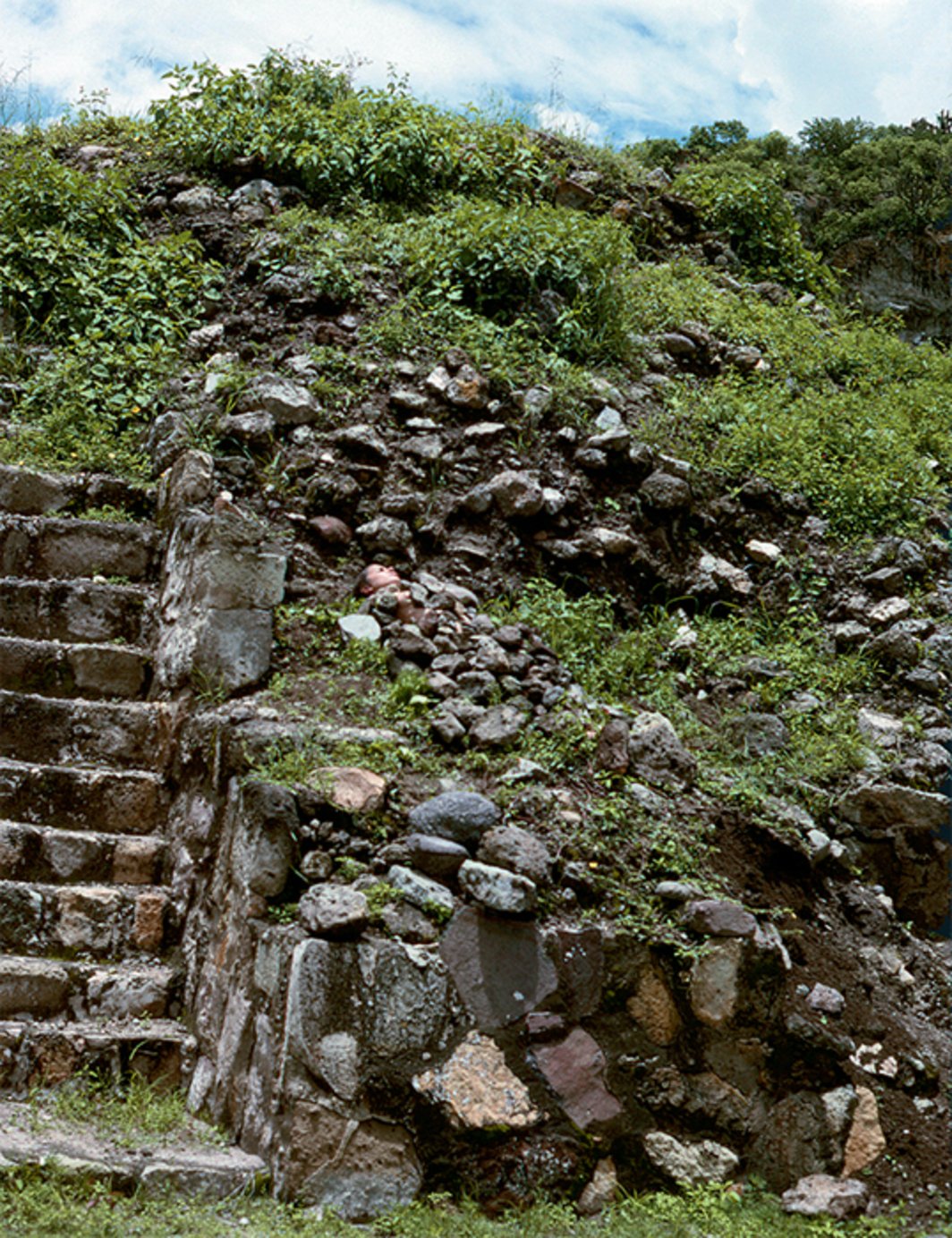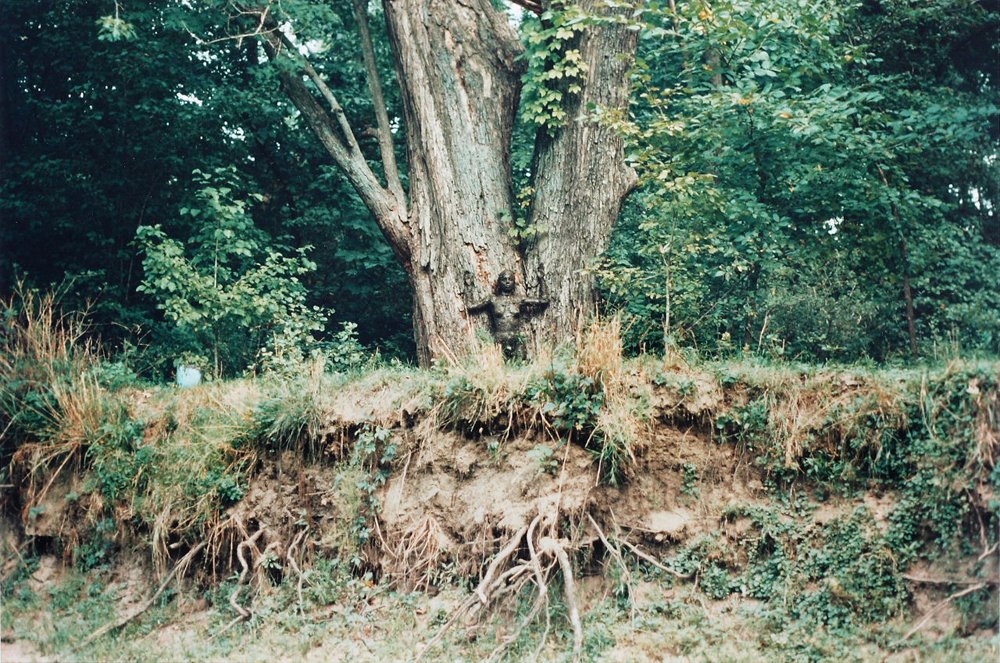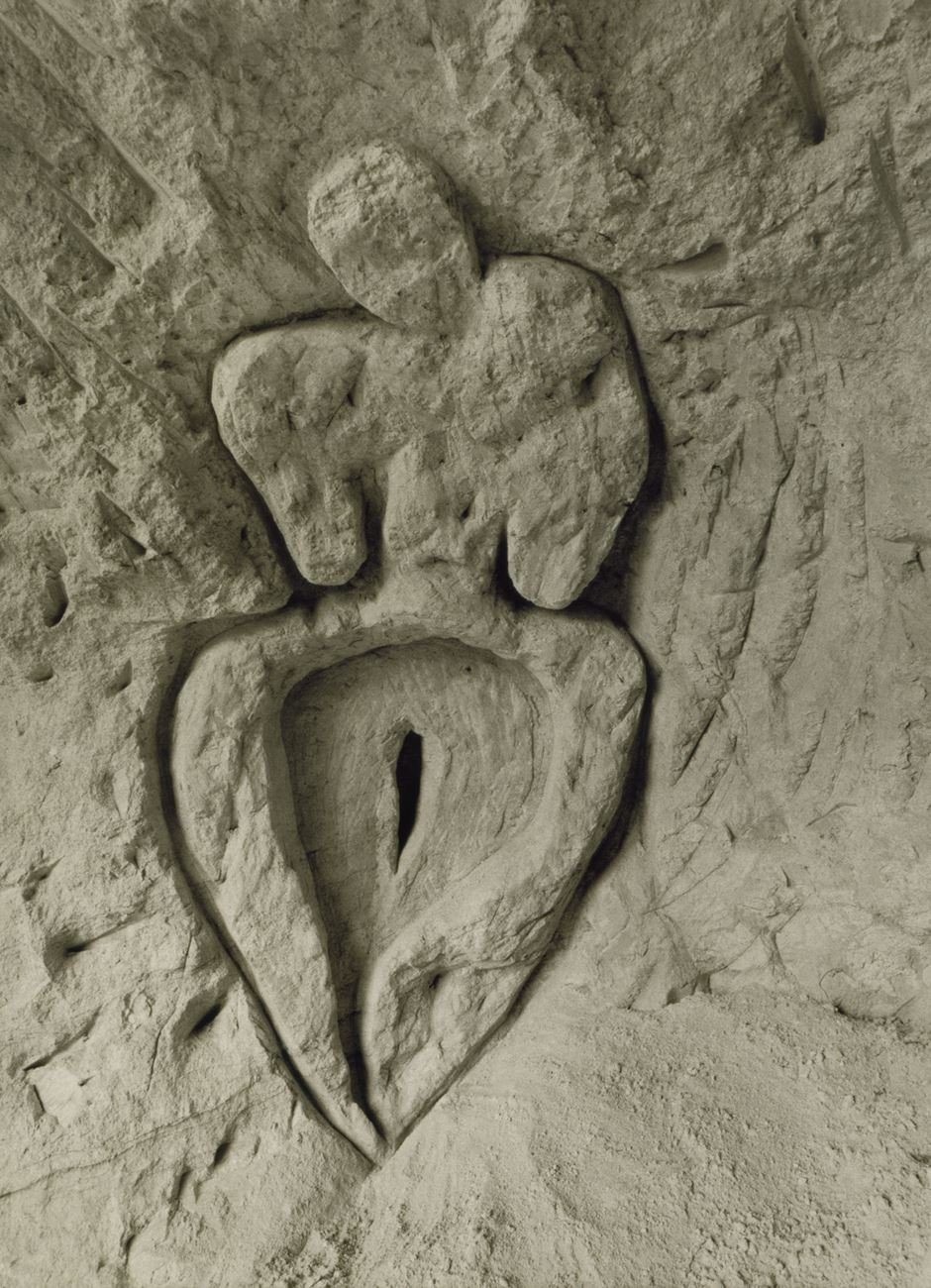Love Letter to Ana Mendieta
Ana Mendieta. Untitled: Silueta Series, Mexico From Silueta Works in Mexico, 1973-1977, 1973. Color photograph. © The Estate of Ana Mendieta Collection, LLC. Courtesy Galerie Lelong & Co. Licensed by the Artist Rights Society (ARS), New York.
I first encountered Ana Mendieta’s work in 2009, when I was a junior in high school. Those were the early days of Tumblr, and my feed presented me with images of many contemporary artists, almost always without their names. They were simply reblogged images, compelling and mysterious and cool. I didn’t know it at the time, but the image seared into my memory was Imagen de Yagul, from Mendieta’s Silueta series (1973–77), and it struck me: the contours of a human body, lying within a cavity of a rock formation, with protruding wildflowers framing limbs and torso, obscuring the face. I was used to seeing so many images of people’s faces—these were still the early days of Facebook after all—and Mendieta’s work challenged that impulse of representation for me. How liberating: in Imagen de Yagul, the face is irrelevant. The image seemed to be about something beyond us as individuals, about the boundary between life and death, of a human body buried among something much older and larger than itself, supported and surrounded by tender, flowering life.
Years later, I would re-encounter Mendieta’s work during a particular moment of adolescent sadness. I was thinking a lot about death, as well as ideas of empathy, vulnerability, and ephemerality. This time, I learned the artist’s name and studied her biography, which utterly shocked me. The circumstances around her traumatic childhood displacement, her sensation of non-belonging in the US, and her investigations into violence and complicity drew me in. The work felt uncharacteristically familiar to me, as if I had finally found a visual artist whose work managed to carry the wounds and subsequent scarring of everyday life, especially for those facing gendered and racialized violence. I fervently studied Mendieta’s images and short videos—whatever I could find online—and I admit, I became quite obsessed. During this time, the power of her work began to challenge that debilitating feeling of melancholic emptiness I could not let go of in my own life. How beautiful and grand it seemed, to be a body amongst a landscape, within and a part of a much broader, seemingly infinite ecosystem.
Ana Mendieta. Burial Pyramid, 1974. Color photograph © The Estate of Ana Mendieta Collection, LLC. Courtesy Galerie Lelong & Co. Licensed by the Artist Rights Society (ARS), New York
Mendieta’s work is radical because she encourages humans to bridge that estrangement between the natural world and modern living. One of her work’s most essential characteristics is proximity to and intimacy with the ground. In Burial Pyramid (1974), Mendieta’s body is covered almost entirely by large rocks. Slowly, her body breathes deeply, over and over again, shifting and tumbling some of the rocks, allowing other parts of her body to emerge. The earth moves with her, in concentrated, meditative motion, although the site itself is grave-like. The human spirit, channeled through the breath, is a vital force in this activation. I am reminded of petrichor, the pleasant smell that fills the air following rainfall. Someone once told me this sweet, fragrant scent of wet earth evokes a feeling of nostalgia for humans, specifically that of our mother’s womb.
On the occasion of Ana Mendieta’s posthumous 1987 retrospective at the New Museum, Marcia Tucker wrote, “Many of her outdoor works were often ephemeral and connected to the earth, subjected to its natural changes. I am not sure that they were intended at all for a museum's neutral, interior walls, but that is the only way now to view them.”¹ I inherently disagree with this perspective. I no longer believe museums are neutral. I also don’t believe in one-directional, traditional viewership. I think Mendieta’s work encourages a different kind of active engagement, beyond the singularity of her artistic authorship. Mendieta once wrote in an artist statement: “The viewer of my work may or may not have had the same experience as myself. But perhaps my images can lead the audience to [speculate] on their own experiences [of] what they might feel I have experienced. Their minds can then be triggered so that the images I present retain some of the quality of the actual experience.”² I began to seek out the actual experience.
The first time I laid naked on the soil, I felt the wetness of moss against my skin, a cold drop of dew sliding down my leg, the ticklish crawl of an ant on my wrist. I felt for a second that my body was not truly my own, but rather, just another organism of the forest. I noticed the rhythm of my own breath, cooling me off and calming me down. It was late summer, and at that moment I felt that I had never really experienced summer before—at least not like this, fully. Inspired by Ana Mendieta’s encouragement, I wrestled with and finally came to accept the emotions that flooded over me. I began to cry, and it felt good. The warm smell of the soil also helped with this process, as did the leaves moving in the wind, the insects, and the flickering sunlight.
Ana Mendieta. Untitled: Silueta Series, Iowa From Silueta Works in Iowa, 1976-1978, 1976-78. Color photograph. © The Estate of Ana Mendieta Collection, LLC. Courtesy Galerie Lelong & Co. Licensed by the Artist Rights Society (ARS), New York.
There is one photograph from Mendieta’s Tree of Life (1976) exploration that haunts me. She stands against a huge, majestic tree with arms outstretched over her head, covered in mud. The lower half of her body is obscured by grasses along a natural embankment. Along the edge of this earth wall we witness the web of roots that support this tree, energetically unfurling towards us. When a plant in the earth dies from winter frost, its stem and foliage wither. Its roots, however, remain buried in the soil—a vibrant, active network in symbiotic relationship with many other species of insects, bacteria, and fungi, among other friends. Even as the plant dies, the roots remain vital, slowly decaying in the soil and providing life-giving nutrients to those who feed from them. Mendieta often spoke of the metaphor of the root: the dynamic force of nature that nurtures and provides a matrilineal inheritance. Expansive, underground, and bustling, like a nascent social movement or a mycelial web. Or perhaps like gunpowder laid on the sand, still dormant yet volatile, embodying the possibility of entropic cataclysm, greater than its current state.
Ana Mendieta. Alma, Silueta en Fuego, 1975. Color photograph. © The Estate of Ana Mendieta Collection, LLC Courtesy Galerie Lelong & Co. Licensed by the Artist Rights Society (ARS), New York
Ana Mendieta. Anima, Silueta de Cohetes (Firework Piece), 1976. Super-8mm film transferred to high-definition digital media, color, silent. Running time: 2:23 minutes. © The Estate of Ana Mendieta Collection, LLC. Courtesy Galerie Lelong & Co. Licensed by the Artist Rights Society (ARS), New York
Mendieta’s insistence on ephemerality is a core, radical aspect of the work. Many of her artworks no longer physically exist, but rather exist simply as documentation of a moment in time, through images, both moving and still. In 1976, Ana Mendieta made Silueta de Cohetes, in which a figure built with arms outstretched is made of fireworks that light up against a night sky. A critic in 1980 described the work as “both beautiful and frightening as the flames sway in the air. The viewer is encouraged to become emotionally consumed in the exhilaration of the flames.”³ I have written about fire in the past, primarily its philosophical and spiritual associations, and about the element’s significance for humanity. I think sometimes I harbor pyromaniacal tendencies, and understand how easy it is to become emotionally consumed. Silueta de Cohetes is a series of moving images that reminds us of the formidable potentiality within ourselves, playing with the notion of time, the lie of its scarcity, and the promise of its relentless circularity.
Ana Mendieta. Ochún, 1981. Black and white photograph. © The Estate of Ana Mendieta Collection, LLC. Courtesy Galerie Lelong & Co. Licensed by the Artist Rights Society (ARS), New York.
Ana Mendieta’s 1981 video Ochún features two ridges made of sand that form a channel through which water flows. These two sculptural walls allude to the curvaceous forms of the human body and do not remain stagnant. The pressure and movement of water from the current informs the curvature of the lines, and the sun’s rays create twinkling reflections in the moving water. In this video, one life force affects the form of another, implying a relationship in motion over time. Mendieta filmed this video off the coast of Key Biscayne, Florida, nodding towards the border (or body of water) that divides nations and ideologies, including that of her Cuban homeland and her subsequent exiled home in the US.
This love letter ends with Mendieta’s Esculturas Rupestres (1981), or rock sculptures, carved into the side of a limestone wall in the forests of Jaruco in Cuba. In these relief sculptures, feminine bodily forms allude to zemis, or Taíno deities that preside over storms, the wind, and the moon, among other natural forces. Guabancex, the supreme storm deity of the Taíno people, is depicted by Mendieta with an almost heart-shaped form, including an incision implying a vaginal chasm and arms that fold into themselves as if they were wings. Due to erosion and lack of maintenance, like so many of her other works, Mendieta’s Esculturas Rupestres no longer remain in the physical landscape, and have deteriorated over time. Nevertheless, these “resonant indentations” represent monumental strength and effort on the part of the artist, pointing to what the late scholar José Esteban Muñoz described as “another way of desiring, of feeling, or radiating a value that resists accumulation and ownership.”⁴ This is another nod of encouragement found in Mendieta’s work: resistance to ownership, or to the idea that the land, this earth beneath our feet, can ever be “owned.” We are simply stewards (at our best) or invasive species (at our worst). Even the artwork in nature can never truly be “owned,” in Mendieta’s case. All that remains are images—beautiful, haunting ones—reminding us of the ephemerality of everything around us, including ourselves.
Ana Mendieta. Maroya (Esculturas Rupestres) [Moon (Rupestrian Sculptures), 1981. Black and white photograph. © The Estate of Ana Mendieta Collection, LLC. Courtesy Galerie Lelong & Co. Licensed by the Artist Rights Society (ARS), New York
Ana Mendieta. Guanaroca and Iyare (From Rupestrian Sculpture Series), 1981. Black and white photograph. © The Estate of Ana Mendieta Collection, LLC. Courtesy Galerie Lelong & Co. Licensed by the Artist Rights Society (ARS), New York
Ana Mendieta. Guanaroca (Esculturas Rupestres) [First Woman (Rupestrian Sculptures)], 1981. Black and white photograph © The Estate of Ana Mendieta Collection, LLC. Courtesy Galerie Lelong & Co. Licensed by the Artist Rights Society (ARS), New York.
If Ana Mendieta were still alive today, she would be 74 years old. I have so many questions: What would her work look like after the advent of the internet? What would her relationship to Cuba be like today? What would she think about the state of the current climate catastrophe? What would she think of today’s art world, completely decentralized, hyper-capitalist, accelerated to an absurd degree? How steadfast would her belief in art be, today? Would she still be curating exhibitions? What might a contemporary version of Dialectics of Isolation look like?⁵ What would she think about the state of white feminism today? How would she respond to the ephemeral works of Cecilia Vicuña? Or the sculptures of Simone Leigh?⁶ Would she still be committed to New York City, or would she have moved elsewhere?What would her dreams for the future be, in 2023? There are so many questions to be asked.
—
Footnotes
¹ Marcia Tucker (1987) Preface and Acknowledgements, Ana Mendieta: A Retrospective, The New Museum of Contemporary Art.
² Ana Mendieta (1977) Artist Statement, Corroboree Gallery of New Concepts (The University of Iowa, IL).
³ Gilbert Coker (1980) Ana Mendieta at A.I.R., Art in America, April: 133–4.
⁴ José Esteban Muñoz (2011) Vitalism's after-burn: The sense of Ana Mendieta, Women & Performance: a journal of feminist theory, 21:2, 191-198.
⁵ A.I.R. Gallery organized an exhibition in 2018 that revisited Dialectics of Isolation: An Exhibition of Third World Women Artists of the United States, originally curated by Ana Mendieta in 1980 at A.I.R. Gallery, where she was a member.
⁶ A 2016 exhibition titled Energy Charge organized by the ASU Art Museum grappled with some of these questions, also included in the exhibition catalog.
Alex Santana is a writer and curator with an interest in conceptual art, political intervention, and public participation. Currently based in New York but originally from Newark, New Jersey, she is currently Associate Editor at The Latinx Project and Programming Fellow at Wassaic Project.









